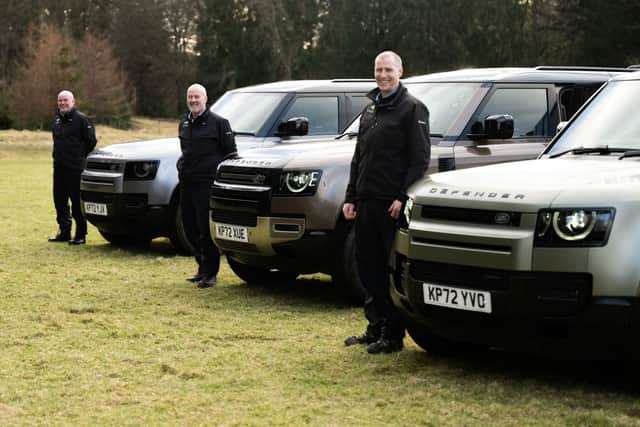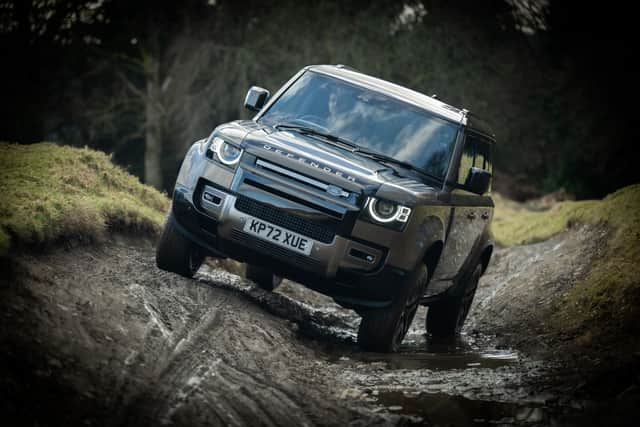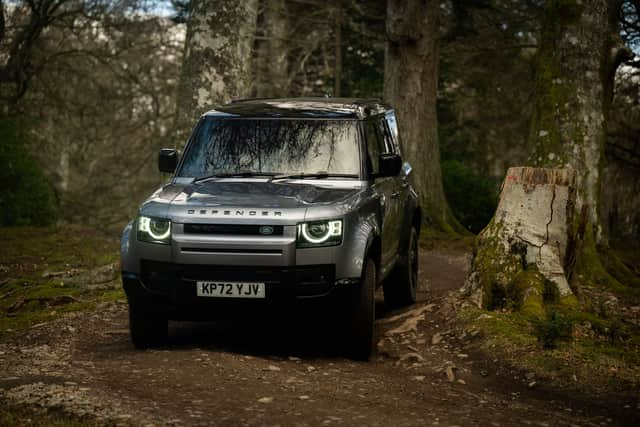Driving the Land Rover Defender off-road in the Perthshire Highlands at Scotland’s Land Rover Experience
Carved wooden signs fixed to the trunks of larch and pine: Diff breaker, Frontera Avenue. The names of some of the obstacles at Scotland’s only official Land Rover Experience center are ominous, or at least the hinted-at origins of the labels seem to be.
Bonnie Prince Charlie camped his army here twice, Malcolm Canmore hid his with branches from nearby Birnam wood en route to vanquishing Macbeth, but I don’t see a plaque for either of them. Today, at the Land Rover Mud and Rucks weekend, we’re interested in an entirely different kind of heritage.
Advertisement
Hide AdAdvertisement
Hide Ad“Frontera Avenue? I’m not sure I can tell you the story behind that,” an instructor laughs, a twinkle in his eye. “One of the other guys might tell you about a Vauxhall that ended up on its roof, though.
Irrespective of whether a poorly-regarded 90s SUV truly met its end here, the idea that one might have come a cropper on the boulder and gnarled tree root-lined stretch of Perthshire hillside is entirely believable. Situated at the gateway to the Highlands, on the 280-acre Dunkeld House Estate, the trails are about as rugged as they come. Sharp inclines, water obstacles and tennis court-size sections of boulders as big as footballs lie in wait for drivers looking to test their mettle. Thankfully I’m here with the experts.
Learning what the Land Rover Defender is capable of
Cameron Allan, Jamie Frame and Keith Sutherland are the instructors tasked with showing me the capabilities of the Land Rover Defender 90, 130 and 110 respectively, their knowledge of the cars second only to their grasp of the muddy stretch of hillside itself.
I’ve done a bit of offroading before, in the Lake District and in a series of former quarries in South Wales, but never in such a stunning surround. And never in such luxury, either. As utilitarian as the Land Rover Defender was during the 67-year continuous run of production that ended in 2016, the new model, launched in 2020, is a more upmarket proposition entirely.


Starting at £58,635 and rising comfortably north of the six figure mark, there’s an understanding that buyers parting with that kind of cash expect a certain level of refinement. And even if they don’t plan to drive it anywhere more exotic than the school run, those buyers expect a certain level of capability too - otherwise, why buy a Land Rover over the many, many other luxury brands pitching their products in that price bracket?
That’s where the Land Rover Experience team come in.
“If you buy a new or approved used Land Rover you get a half-day voucher from them to come along and experience the vehicle off-road,” Cameron tells me.
“People come along, they use our vehicles and we show them what the vehicle can do so, hopefully, they get the best out of it.”
There are nine Land Rover experience centers across the UK and Dunkeld is the only one north of the border. Blasting around their network of tracks with the reassuring company of a fully-qualified instructor - and in someone else’s car - is definitely something to be recommended. While it’s undoubtedly a blast, a great loyalty perk for Land Rover customers, there are real practical benefits as well.
Advertisement
Hide AdAdvertisement
Hide Ad“There’s a lot of functions in these and, with the best will in the world, the salesperson isn’t going to be able to go through all of it when he’s handing the keys over to you,” adds Cameron.
“We’re here to show them how to do it and how they can use these functions on the road in adverse weather as much as off road.”
Functions like the terrain response system. Accessed via the touch-screen interface it allows drivers to adjust the car settings for the terrain ahead, tailoring throttle response, traction control, gearbox, hill descent and differential settings according to your selection. With five options - sand, rock crawl, grass-gravel-snow, mud ruts and general, the purpose of each setting is obvious once you know how to use them - but how many owners are confident enough to select them off their own bat? I’d guess about as many as actually use the paddles on their DSG gearboxes rather than keep their cars in auto.


And perhaps the purpose of each setting isn’t as obvious as it might seem at first glance: “I tell everyone that grass-gravel-snow is the setting that you should be in 60 per cent of the time when you’re driving in Scotland,” says Jamie as he puts me through my paces in the all-new Defender 130, Land Rover’s new eight-seater offering aimed firmly at the North American market.
“When you’re off-roading?” I seek to clarify.
“No, all the time.”
Just as UK drivers have been slower than our Northern European counterparts at embracing tyres for specific seasons, it appears many of us aren’t making the most of the built-in settings that ship with the millions of SUVs that seemingly dominate our roads.
Upmarket design, uncompromising capability
Dominant isn’t a bad adjective to describe the modern Defender. The design pays homage to Land Rover’s utilitarian DNA, with square lines and exposed interior ironmongery, but it’s far more muscular than the old car. The 130 is over five meters long and 2.1 meters wide with the mirrors out. While the 90 is only four and a half meters long with the spare wheel attached, it’s still two meters tall and 2.1 meters wide.
Driving the backroads of Dunkeld en route to the off-road center, we passed a Volkswagen Passat - 1.8 meters wide and 1.4 meters tall, if you’re wondering - and I felt like a voyeur lorry driver glancing at the top of the driver’s head through the sunroof as I bullied my way past. This is a car that I would, frankly, hate to have to park in the supermarket.
But off the road, something peculiar happens. I’m slaloming the Defender through narrow woodland trails that I’d think twice about attempting on a pushbike. It’s partly down to the impressive turning circle - 11.3 meters kerb-to-kerb in the 90, tighter than the old 2016 model could achieve - and partly down to being surrounded by twelve meter tall forest, but the car feels suddenly compact and is no longer the biggest thing in view.
Advertisement
Hide AdAdvertisement
Hide AdAs tailored as it is for an upmarket audience, it’s clear the Defender is engineered for exactly this environment. We take a route designed to show off the 37.5 degree approach angle and 28.5 degree departure up acute slopes and over the as-bouncy-as-it-sounds Toblerone. We pause at the top of one particularly sharp hump which transitions into a tight turn and balance the car on two wheels diagonally.
Through a rat run of muddy ditches cut into the earth like a mini Grand Canyon we have the car tilted sideways more times than I’m comfortable with. None of the instructors will be drawn on the limits of the car in terms of horizontal angle. “There are too many variables,“ says Keith. “The passengers, whether you have a roof box fitted, the tyres would all change it.”
The front and rear-facing cameras have proven essential throughout the morning. On terrain as rough as this bonnet blindness - being unable to see the obstacle in front of you - is a real problem and in off-roading, the position of your tyres is everything. There are sections where we navigate purely by the view on the 11.4-inch touch-screen. The hardest bit was undoing twenty years of muscle memory as my brain tried to keep my eyes on the road.


“We had an 11-year-old out on one of our Junior Land Rover Experiences the other day who went round the whole course like that,” Jamie tells me. I feel positively ancient.
As dramatic as some of the challenges set for us are,the complete lack of drama in the cabin is a sharp contrast. The diesel and petrol engines tested are quiet and refined, particularly 400 horsepower, six-cylinder petrol. The cabin is comfortable and the air suspension fitted to all three of the test models soaks up everything we throw at it.
The purpose of the day might be to show us what the Defender is capable of, but I come away with a sense that we don’t get anywhere near its limits.
Comments
Want to join the conversation? Please or to comment on this article.
